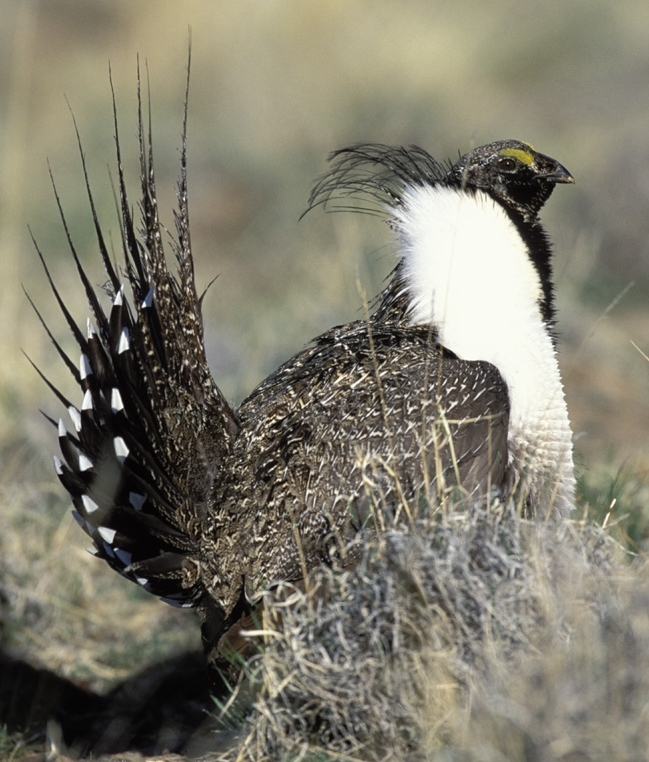|
| Query: Centrocercus urophasianus | Result: 2nd of 28 | |
Greater Sage Grouse (Centrocercus urophasianus) - Wiki
| Subject: | Greater Sage Grouse (Centrocercus urophasianus) - Wiki
| |

| Resolution: 649x762
File Size: 319636 Bytes
Upload Date: 2007:10:26 11:53:46
|
Sage Grouse
From Wikipedia, the free encyclopedia
[Photo] Greater Sage Grouse (Centrocercus urophasianus) public domain from Gary Kramer, USFWS: http://www.fws.gov/graphics/sagegrouse.jpg ; http://www.r6.fws.gov/species/birds/sagegrouse/
The Greater Sage-grouse, Centrocercus urophasianus, is the largest grouse in North America . Adults have a long, pointed tail and legs with feathers to the toes. Adult males have a yellow patch over the eye, are greyish on top with a white breast, a dark brown throat and a black belly; two yellowish sacs on the neck are inflated during courtship display. Adult females are mottled grey-brown with a light brown throat and dark belly.
The breeding habitat for the Sage-grouse is sagebrush country in the western United States and southern Alberta and Saskatchewan. They nest on the ground under sagebrush or grass patches. In May 2000, the Canadian Species at Risk Act listed the Greater Sage-Grouse phaios subspecies, the population found in British Columbia, as being extirpated in Canada.
Sage-grouse are notable for their elaborate courtship rituals. Each spring males congregate on leks and perform a "strutting display". Groups of females observe these displays and select the most attractive males to mate with. Only a few males do most of the breeding. Males perform on leks for several hours in the early morning and evening during the spring months. Leks are generally open areas adjacent to dense sagebrush stands, and the same lek may be used by grouse for decades.
This species is a permanent resident. Some move short distances to lower elevations for winter. These birds forage on the ground. They mainly eat sagebrush, also insects and other plants. They are not able to digest hard seeds like other grouse.
The numbers of this species are declining due to loss of habitat; their range has shrunk in historical times, having been extirpated from British Columbia, Kansas, Nebraska, Oklahoma, Arizona and New Mexico. This species, as well as the Mono Sage Grouse (a probable subspecies) have been petitoned for listing under the Endangered Species Act. However, the US Fish & Wildlife Service, for political reasons, has refused to list them.
The Sagehen is the mascot of the Pomona College and Pitzer College athletic teams (Claremont, CA).
The Greater Sage-grouse is also known as the Sagehen, Sage-grouse or Sage Cock. The Greater Sage-grouse is also known as cock of the plains.
http://en.wikipedia.org/wiki/Sage_Grouse
| The text in this page is based on the copyrighted Wikipedia article shown in above URL. It is used under the GNU Free Documentation License. You may redistribute it, verbatim or modified, providing that you comply with the terms of the GFDL. |
|
Comments |
|---|
| | Guest |
|
Scientific Name: Centrocercus urophasianus (Bonaparte, 1827)
Common Names: Sage Grouse, Greater Sage-Grouse
French: Tétras des armoises German: Beifußhuhn Spanish: Gallo de las artemisas grande
Taxonomy: Tetrao urophasianus Bonaparte, 1827, “North-western countries beyond the Mississippi especially on the Missouri”. |
 |

|

|
Centrocercus urophasianus
2/28 |

|

|
^o^
Animal Pictures Archive for smart phones
^o^
|
|
|